How Many Times Can You Have a Total Knee Replacement
Knee Replacement
Knee replacement is one of the most successful orthopedic surgeries performed today. Almost patients feel reduced or eliminated human knee pain, increased ability to motility and an overall comeback in quality of life.
HSS performs more full knee replacement surgeries than whatsoever other U.s. hospital. HSS surgeons invented the first modernistic total knee replacement in the 1970s and have continually improved on surgical techniques, technology and prosthetic materials ever since. In 2020, HSS became the first hospital in the U.s. to complete a full knee replacement using augmented reality (AR) assistance. *
What is knee replacement surgery?
Knee replacement is where portions of the bones that form the knee joint are removed and replaced with bogus implants. It is performed primarily to relieve knee pain and stiffness caused by osteoarthritis.
Most people who get this surgery have avant-garde articulatio genus arthritis, in which the knee joint cartilage is worn abroad and the surface of the knee becomes pitted, eroded, and uneven. This causes pain, stiffness, instability and a modify in body alignment. Knee replacement surgery tin too help some people who take a weakened human knee caused by an injury or other condition. (Find a knee joint replacement specialist at HSS.)
What are the different types of knee replacement surgery?
There are 2 main types:
- total knee replacement, where the entire joint is replaced with bogus surfaces
- partial knee joint replacement, where simply i damaged compartment of the genu is replaced
Full genu replacement is the more than mutual of these two procedures.
Human knee anatomy
To sympathise a total genu replacement, as well known as total condylar knee arthroplasty, y'all must be familiar with the structure of the human knee, a complex articulation that consists of three bones:
- the femur (thighbone)
- the tibia (shinbone)
- the patella (kneecap)
Strong ligaments connect the powerful muscles of the thigh and calf to the bones effectually the knee to control knee move and function. Cartilage (such equally the meniscus) and other soft tissues cover and cushion the bones to help them glide together smoothly.
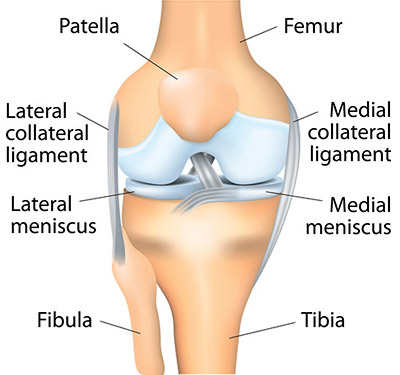
When you bend or straighten your human knee, the end of the femur rolls confronting the end of the tibia, and the patella glides in front of the femur.
When the cartilage that cushions the joint degrades or is worn away completely, the bones rub together and become scraped and rough. This causes inflammation known as osteoarthritis, which results in hurting and stiffness that make walking and other movement difficult. The implants used in knee joint replacement are smooth like the surfaces of a good for you knee.
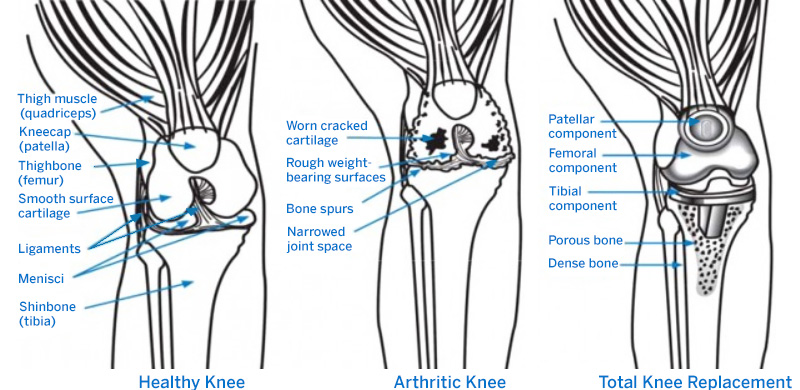
How is a total human knee replacement performed?
Beginning, the orthopedic surgeon makes an incision (cut) in the knee and moves the patella (kneecap) to the side. If are any os spurs (small bony growths) are present, every bit sometimes occurs in osteoarthritis, they will be removed.
Next, the 2 menisci between the femur and tibia are removed, as are the inductive cruciate ligament (ACL) and, in some cases, the posterior cruciate ligament (PCL). In some types of knee replacement, the PCL is retained.
During the primary phase of the functioning, the surgeon cuts and remove cartilage and some bone from the upper part of the tibia and lower sections of the femur. The femoral sections removed are two knobby protuberances chosen the femoral condyles. The tibia and femur are then exist capped with metal implants to create new surfaces for the articulation. The surface of the femoral component mimics the shape of the original femoral condyles. If the kneecap has as well degraded, the surface on its underside may also be cut away and replaced with a polyethylene implant.
Finally, the various layers of tissue are repaired with dissolvable sutures and the pare incision is airtight with sutures or surgical staples. A cast will be wrapped around the knee and the patient is be taken to recovery.
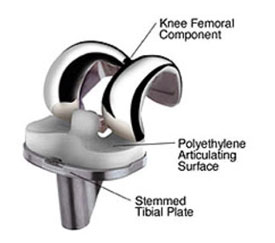
Fixed-bearing articulatio genus implant with a polyethylene articulating surface (plastic tray) sandwiched betwixt the metal tibial implant and metal femoral implant.
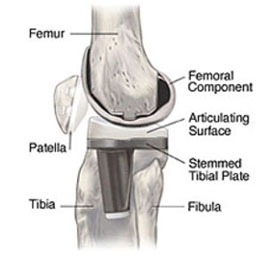
Side-view illustration of a knee with a fixed-bearing human knee implant in identify.
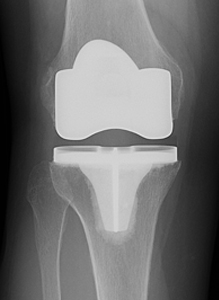
Ten-ray of a knee later total knee replacement, showing the implanted prosthesis)
What are genu replacement implants made of?
The selection of knee replacement prosthesis design and materials depends on each individual patient. The master implant components are made of metal – usually titanium or chrome-cobalt alloys. The implants are fixated in place either with a cement bonding agent or by osseointegration, in which a porous metal stem extends into the tibia and the patient's natural bone grows into information technology. A plastic platform or spacer will be inserted between the tibial and femoral implant surfaces. The spacer is made of polyethylene.
About femoral components are made of metal alloys (cobalt chromium) or metal-ceramic alloys (oxidized zirconium). The patellar component is plastic (polyethylene). The tibial insert component is also plastic (polyethylene). The tibial tray component tin be fabricated of the following materials:
- cobalt chromium (metallic alloy)
- titanium (metal alloy)
- polyethylene (plastic)
Video: Animation of a total knee replacement
Fractional knee replacement overview
A partial articulatio genus replacement is likewise known as unicompartmental knee arthroplasty or unicondylar knee arthroplasty. In this surgery, damaged cartilage and bone are removed and replaced only in i diseased compartment of the human knee. This differs from a total human knee replacement, in which bone and cartilage from the entire joint are replaced.
Partial knee replacement is suitable for people who experience arthritis but in one compartment (department) of the knee joint, rather than throughout the joint. Information technology can also provide relief from hurting and stiffness in some people who have medical weather condition that brand them poor candidates for total knee replacement surgery.
Can I avert or postpone a knee replacement?
The choice on whether to take surgery to address arthritis of the articulatio genus articulation depends on multiple factors, including:
- the status of the knee joint joint
- the patient's age and action level
In cases where the harm from arthritis is minimal, and/or if the patient does not accept a very active lifestyle, nonsurgical treatments by exist tried, including:
- concrete therapy
- NSAIDs (nonsteroidal anti-inflammatory drugs), such every bit ibuprofen
- weight loss to reduce pressure on the knee
How do I know if I need knee joint replacement surgery?
You may need surgery if:
- Your knees are stiff and swollen.
- There is pain throughout the day, even at remainder.
- Walking, getting up or climbing stairs is difficult and painful.
- Medication and therapy practice not offer enough relief.
- Knee cartilage is so damaged and worn away that you lot are walking "bone on bone," in which the bones of the joint are scraping together.
(Observe a knee replacement surgeon at HSS.)
How long does a knee replacement concluding?
Knee replacement implants are expected to function for at least fifteen to 20 years in 85% to 90% of patients. Yet, the implants exercise not concluding forever.
After a period of 15 to 20 years, general wearable and tear may loosen the implant. Depending on the patient, this may cause no symptoms, or it may crusade any of the post-obit:
- hurting
- loose implant particles
- knee instability
- infection
When these symptoms arise, orthopedic surgeons recommend having knee revision surgery to replace the original implant. Infection, especially, requires a prompt revision surgery. Infection after human knee replacement surgery is rare, but a knee replacement implant cannot defend itself from infection if bacteria are introduced to the body. Learn more nearly the low infection rates at HSS.
Can knee replacement be done as an outpatient?
Most patients stay in the hospital one or two nights later on surgery. Some patients are able to render home the same day later an outpatient procedure. Learn more by reading Outpatient Knee Replacement Surgery: Often Asked Questions.
Knee replacement recovery time and recuperation
Total knee joint replacement surgery mostly takes almost lx to 90 minutes, but you should expect to exist in the operating room for over 2 hours. Rehabilitation (physical therapy) will begin inside 24 hours of surgery.
After your surgery, the nursing staff will position yous in bed and help you plow until you are able to motion on your ain. You may have a pillow between your legs if ordered past your surgeon.
Very before long after surgery, a physical therapist volition come to your room to teach you advisable exercises and review your progress. Gentle exercises to better your range of move tin can help prevent circulation problems as well as strengthen your muscles.
Your rehabilitation program will begin every bit soon as you are medically stable and at that place are orders from your medico to begin postoperative mobility. All patients begin rehabilitation within 24 hours of their surgery. Your motivation and participation in your physical therapy plan is key to the success of your surgery and recovery. The physical therapist will assist you in the following activities:
- sitting at bedside with your feet on the flooring
- transferring in and out of bed safely
- walking with the help of a device (walker, cane, or crutches)
- climbing stairs with aid of a device
How long is it before I tin can walk after a knee replacement?
Most patients progress to a straight cane, walker or crutches within ii or iii days after surgery. As the days progress, the altitude and frequency of walking volition increase.
Patients are usually able to drive a car within three to six weeks afterwards surgery and resume all other normal activities past or earlier six weeks. Complete recuperation and render to full force and mobility may take upwardly to 4 months. However, in many cases, patients are significantly more mobile one month after surgery than they were before they had their knee replacement
What tin I expect at HSS?
Infirmary for Special Surgery has been at the forefront of modern human knee replacement since the operation was first introduced in the late 1960s. We take led the field ever since in a number of ways:
- The numbers: HSS has been ranked the No. 1 hospital for orthopedics by U.Due south. News & Earth Written report for 11 years straight.
- Along with high rankings in patient satisfaction, HSS performs the most knee replacements with the everyman reported infection rates in the United States.
- Research and advancement: Smaller incisions, new implant materials and design, and sophisticated instrumentation have been – and go on to exist – the areas of expertise of the hip and articulatio genus replacement surgeons of the HSS Adult Reconstruction & Joint Replacement Service.
- HSS routinely uses the latest surgical techniques and applied science, such as robotic-assisted and computer-assisted surgery.
- Regional anesthesia: Isolating the anesthesia to a particular body area helps avoid the potential bug that may back-trail a full general anesthetic. These techniques have been developed and refined by the HSS Section of Anesthesiology, Critical Care & Pain Management. Acquire more about Safe Knee Surgery: How Anesthesiology Plays a Office
How to set up for articulatio genus replacement
There are certain steps that tin better your recovery time and results. It is important to follow your knee replacement surgeon's instructions both before and after surgery, besides as that of your rehabilitation therapist'south recommendations. Learn more nearly reparing for human knee replacement by reading Your Pathway to Recovery: A Patient's Guide to Full Knee Replacement (TKR).
References
Back in the Game patient stories
Source: https://www.hss.edu/condition-list_knee-replacement.asp
0 Response to "How Many Times Can You Have a Total Knee Replacement"
Post a Comment